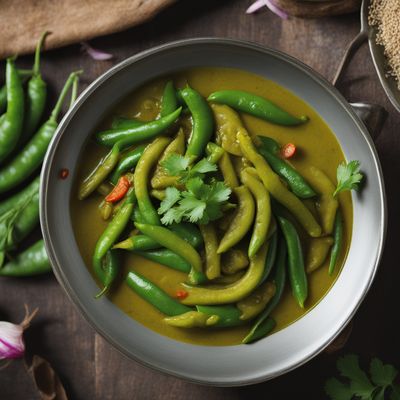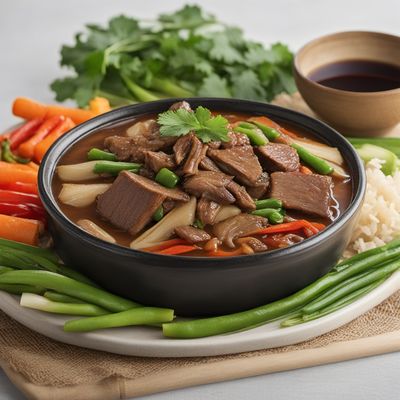
Ingredient
Cheese, prastost
The Alpine Delicacy
Prastost cheese, hailing from the Alpine regions of Europe, is a semi-hard cheese with a firm yet creamy texture. It features a rich, nutty flavor profile with hints of caramel and a slightly sweet undertone. The cheese has a pale yellow interior and a natural rind that develops during the aging process.
Origins and history
Prastost cheese has a long history in Alpine regions, particularly in Switzerland and Austria. It has been produced for centuries by local farmers and cheesemakers, who utilize the abundant supply of milk from cows grazing on Alpine pastures. Prastost cheese is deeply rooted in the culinary traditions of the region and is often enjoyed in dishes like fondue, raclette, and gratins.
Nutritional information
Prastost cheese is a good source of protein and calcium, essential for maintaining strong bones and supporting various bodily functions. It also contains vitamins like vitamin A and vitamin B12. However, it is important to consume it in moderation due to its relatively high fat content.
Allergens
Prastost cheese may contain lactose, making it unsuitable for individuals with lactose intolerance. It is also not suitable for those with dairy allergies. It is advisable to check the ingredient list and consult with a healthcare professional if needed.
How to select
When selecting Prastost cheese, look for well-aged varieties that have a firm texture and a natural rind. The cheese should have a pleasant aroma and a pale yellow interior. Avoid cheeses with an overly strong or pungent smell, as it may indicate spoilage.
Storage recommendations
To maintain the freshness and quality of Prastost cheese, it is best to store it in the refrigerator. Wrap it tightly in wax paper or cheese paper to allow it to breathe while protecting it from moisture and odors. Proper storage will help prevent the cheese from drying out or absorbing unwanted flavors.
How to produce
Prastost cheese is typically produced by skilled cheesemakers using traditional methods. The process involves curdling milk, separating the curds from the whey, pressing the curds, and aging the cheese for several months. Due to the complexity of the production process and the need for specific aging conditions, it is challenging for amateurs to produce Prastost cheese at home.
Preparation tips
Prastost cheese can be enjoyed in various ways, such as melted in fondues or raclette, grated over gratins or pasta dishes, or simply enjoyed on a cheeseboard with crusty bread and fruits. Its rich and nutty flavor pairs well with cured meats, pickles, and sweet preserves.
Culinary uses
Prastost cheese is a staple in Alpine cuisine and is commonly used in traditional dishes like fondue, raclette, and gratins. It is also enjoyed on its own or as part of a cheese platter. The cheese's rich and nutty flavor adds depth to savory dishes and complements a variety of ingredients.
Availability
Prastost cheese is primarily produced and consumed in Alpine regions, particularly in Switzerland and Austria. It is also available in some specialty cheese shops or gourmet markets in other countries.
More ingredients from this category » Browse all

Cheese, danbo
The Danish Delight: Exploring the Savory World of Danbo Cheese

Cheese, Monterey Jack
Monterey Jack: The Creamy Delight

Cheese, nokkelost
"Nokkelost: The Spiced Delight of Scandinavian Cheeses"

Cheese, trappist
The Monastic Delight

Cheese, toma piemontese
The Creamy Delight

Cheese, sao jorge
The Azorean Delight

Cheese, vacherin fribourgeois
The Creamy Delight: Vacherin Fribourgeois Cheese

Cheese, passendale
Passendale: The Belgian Delight

Cheese, tronchon
The Art of Tronchon: A Savory Cheese Delight

Cheese, raschera
The Creamy Delight: Unveiling the Secrets of Raschera Cheese

Cheese, lancashire
The Creamy Delight

Cheese, arzua ulloa
The Creamy Delight
Recipes using Cheese, prastost » Browse all

Crispy Green Bean Fritters
Savor the Crunch: Crispy Green Bean Fritters from Portugal

Luxembourgian Cialledda with Local Flavors
Luxembourgian Harvest Salad: A Celebration of Local Produce

Urap Asunción Style
Tropical Delight Urap: A Fusion of Indonesian and Asunción Flavors

Burmese-style Green Bean Curry
Savory Delight: Burmese Green Bean Curry

Malagasy-style Sukiyaki
Madagascar's Flavorful Sukiyaki Delight

Konoha-don: Forest-Inspired Rice Bowl
Sakura Blossom Rice Bowl: A Taste of the Japanese Forest

Tempeh Stir-Fry with Spicy Sweet Sauce
Fiery Tempeh Delight: A Spicy Twist on Indonesian Stir-Fry

Valencian-style Green Bean Stew
Festive Frijoles: A Valencian Twist on Green Bean Stew

Khoresh Lubia Sabz with Persian Flavors
Persian Green Bean Stew: A Burst of Flavors from Iran

Nouvelle Tendon Delight
Crispy Delights: A Nouvelle Twist on Tendon

North East Indian-Style Green Beans Curry
Spicy and Flavorful Green Beans Curry from the North East

Japanese Chinese Style Vegetable Soup
Umami Infused Vegetable Delight: A Fusion of Japanese and Chinese Flavors